2017 NISSAN ARMADA ECU
[x] Cancel search: ECUPage 30 of 614
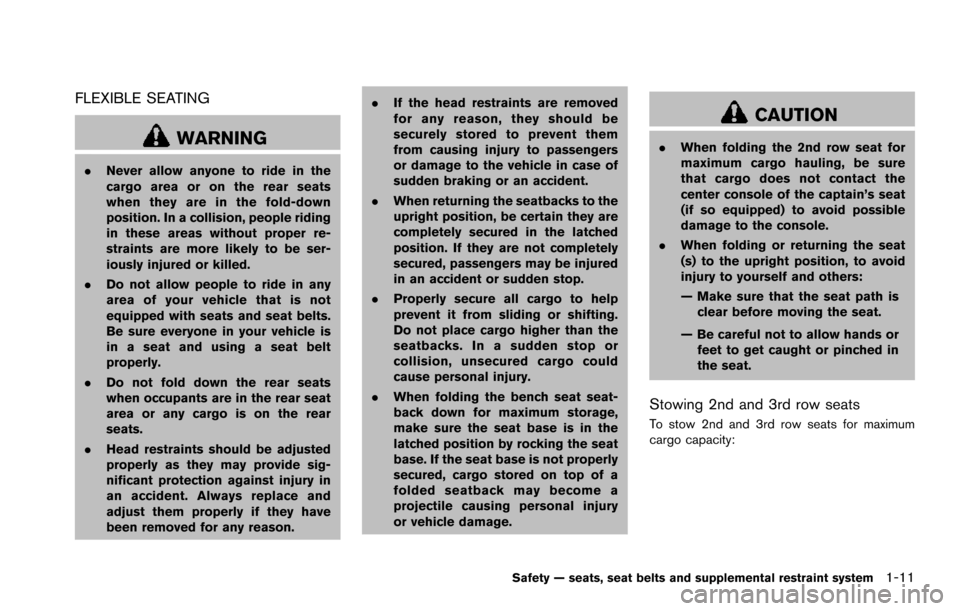
FLEXIBLE SEATING
WARNING
.Never allow anyone to ride in the
cargo area or on the rear seats
when they are in the fold-down
position. In a collision, people riding
in these areas without proper re-
straints are more likely to be ser-
iously injured or killed.
. Do not allow people to ride in any
area of your vehicle that is not
equipped with seats and seat belts.
Be sure everyone in your vehicle is
in a seat and using a seat belt
properly.
. Do not fold down the rear seats
when occupants are in the rear seat
area or any cargo is on the rear
seats.
. Head restraints should be adjusted
properly as they may provide sig-
nificant protection against injury in
an accident. Always replace and
adjust them properly if they have
been removed for any reason. .
If the head restraints are removed
for any reason, they should be
securely stored to prevent them
from causing injury to passengers
or damage to the vehicle in case of
sudden braking or an accident.
. When returning the seatbacks to the
upright position, be certain they are
completely secured in the latched
position. If they are not completely
secured, passengers may be injured
in an accident or sudden stop.
. Properly secure all cargo to help
prevent it from sliding or shifting.
Do not place cargo higher than the
seatbacks. In a sudden stop or
collision, unsecured cargo could
cause personal injury.
. When folding the bench seat seat-
back down for maximum storage,
make sure the seat base is in the
latched position by rocking the seat
base. If the seat base is not properly
secured, cargo stored on top of a
folded seatback may become a
projectile causing personal injury
or vehicle damage.
CAUTION
.When folding the 2nd row seat for
maximum cargo hauling, be sure
that cargo does not contact the
center console of the captain’s seat
(if so equipped) to avoid possible
damage to the console.
. When folding or returning the seat
(s) to the upright position, to avoid
injury to yourself and others:
— Make sure that the seat path is
clear before moving the seat.
— Be careful not to allow hands or feet to get caught or pinched in
the seat.
Stowing 2nd and 3rd row seats
To stow 2nd and 3rd row seats for maximum
cargo capacity:
Safety — seats, seat belts and supplemental restraint system1-11
Page 33 of 614
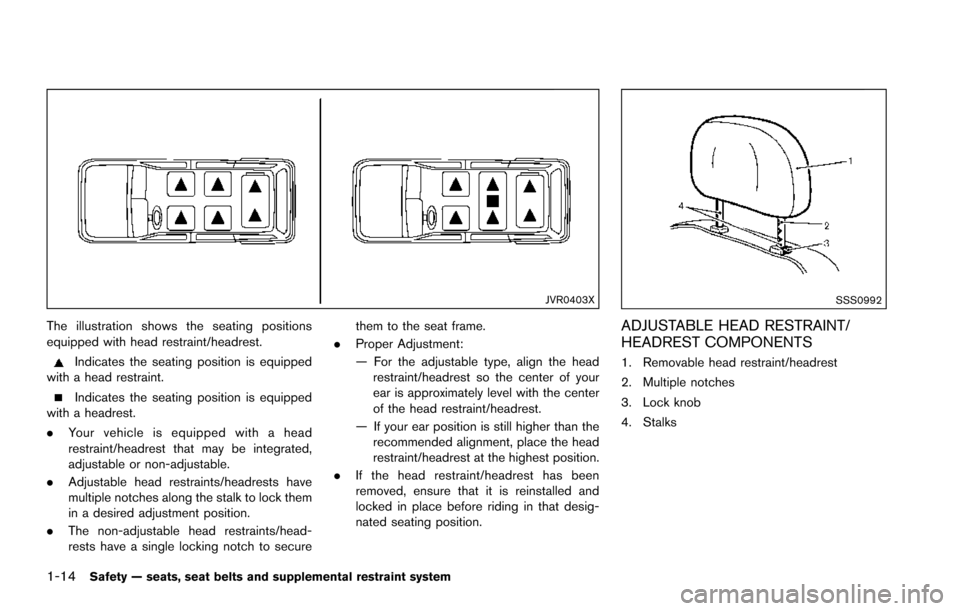
1-14Safety — seats, seat belts and supplemental restraint system
JVR0403X
The illustration shows the seating positions
equipped with head restraint/headrest.
Indicates the seating position is equipped
with a head restraint.
Indicates the seating position is equipped
with a headrest.
. Your vehicle is equipped with a head
restraint/headrest that may be integrated,
adjustable or non-adjustable.
. Adjustable head restraints/headrests have
multiple notches along the stalk to lock them
in a desired adjustment position.
. The non-adjustable head restraints/head-
rests have a single locking notch to secure them to the seat frame.
. Proper Adjustment:
— For the adjustable type, align the head
restraint/headrest so the center of your
ear is approximately level with the center
of the head restraint/headrest.
— If your ear position is still higher than the recommended alignment, place the head
restraint/headrest at the highest position.
. If the head restraint/headrest has been
removed, ensure that it is reinstalled and
locked in place before riding in that desig-
nated seating position.
SSS0992
ADJUSTABLE HEAD RESTRAINT/
HEADREST COMPONENTS
1. Removable head restraint/headrest
2. Multiple notches
3. Lock knob
4. Stalks
Page 34 of 614
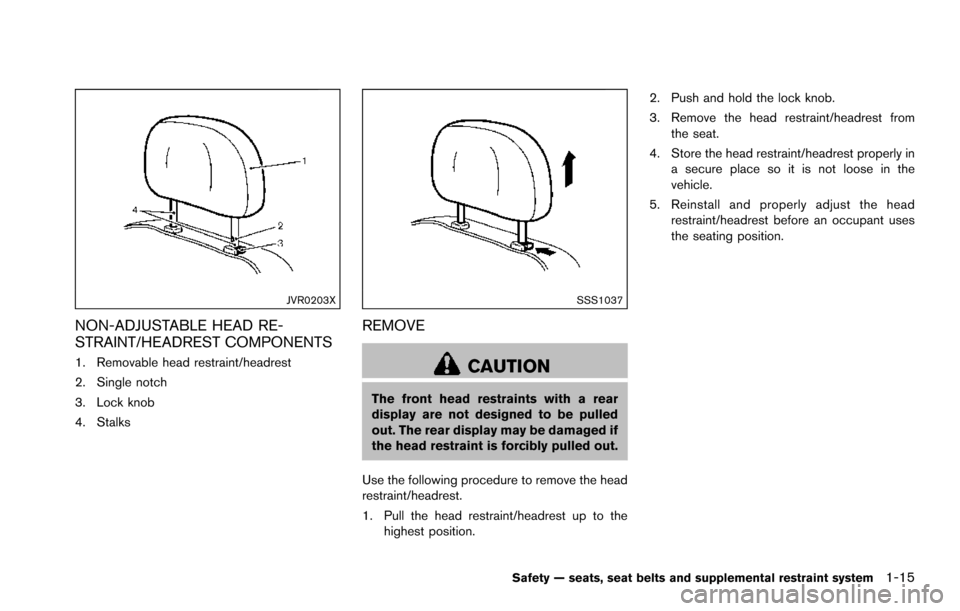
JVR0203X
NON-ADJUSTABLE HEAD RE-
STRAINT/HEADREST COMPONENTS
1. Removable head restraint/headrest
2. Single notch
3. Lock knob
4. Stalks
SSS1037
REMOVE
CAUTION
The front head restraints with a rear
display are not designed to be pulled
out. The rear display may be damaged if
the head restraint is forcibly pulled out.
Use the following procedure to remove the head
restraint/headrest.
1. Pull the head restraint/headrest up to the highest position. 2. Push and hold the lock knob.
3. Remove the head restraint/headrest from
the seat.
4. Store the head restraint/headrest properly in a secure place so it is not loose in the
vehicle.
5. Reinstall and properly adjust the head restraint/headrest before an occupant uses
the seating position.
Safety — seats, seat belts and supplemental restraint system1-15
Page 39 of 614
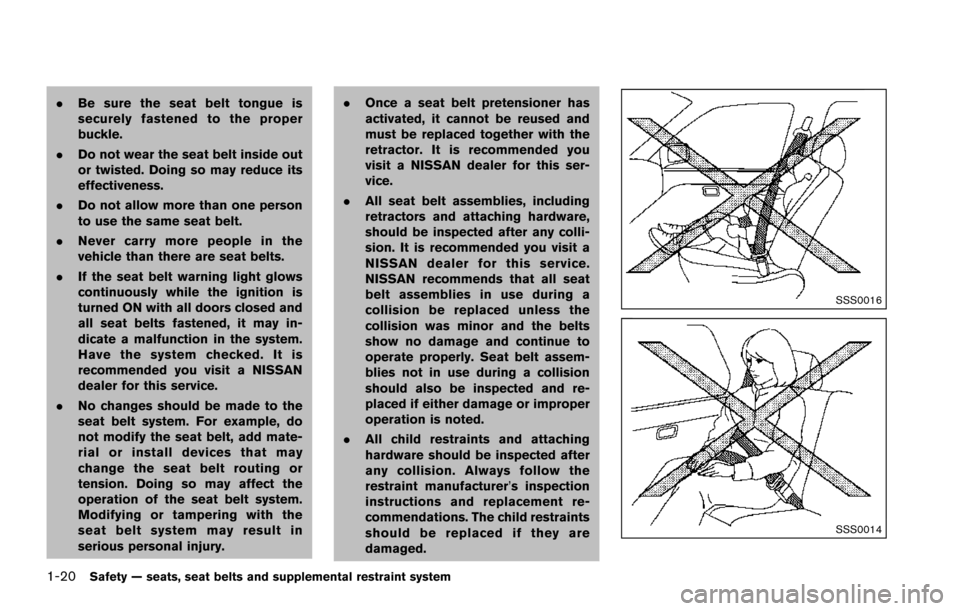
1-20Safety — seats, seat belts and supplemental restraint system
.Be sure the seat belt tongue is
securely fastened to the proper
buckle.
. Do not wear the seat belt inside out
or twisted. Doing so may reduce its
effectiveness.
. Do not allow more than one person
to use the same seat belt.
. Never carry more people in the
vehicle than there are seat belts.
. If the seat belt warning light glows
continuously while the ignition is
turned ON with all doors closed and
all seat belts fastened, it may in-
dicate a malfunction in the system.
Have the system checked. It is
recommended you visit a NISSAN
dealer for this service.
. No changes should be made to the
seat belt system. For example, do
not modify the seat belt, add mate-
rial or install devices that may
change the seat belt routing or
tension. Doing so may affect the
operation of the seat belt system.
Modifying or tampering with the
seat belt system may result in
serious personal injury. .
Once a seat belt pretensioner has
activated, it cannot be reused and
must be replaced together with the
retractor. It is recommended you
visit a NISSAN dealer for this ser-
vice.
. All seat belt assemblies, including
retractors and attaching hardware,
should be inspected after any colli-
sion. It is recommended you visit a
NISSAN dealer for this service.
NISSAN recommends that all seat
belt assemblies in use during a
collision be replaced unless the
collision was minor and the belts
show no damage and continue to
operate properly. Seat belt assem-
blies not in use during a collision
should also be inspected and re-
placed if either damage or improper
operation is noted.
. All child restraints and attaching
hardware should be inspected after
any collision. Always follow the
restraint manufacturer’s inspection
instructions and replacement re-
commendations. The child restraints
should be replaced if they are
damaged.
SSS0016
SSS0014
Page 42 of 614
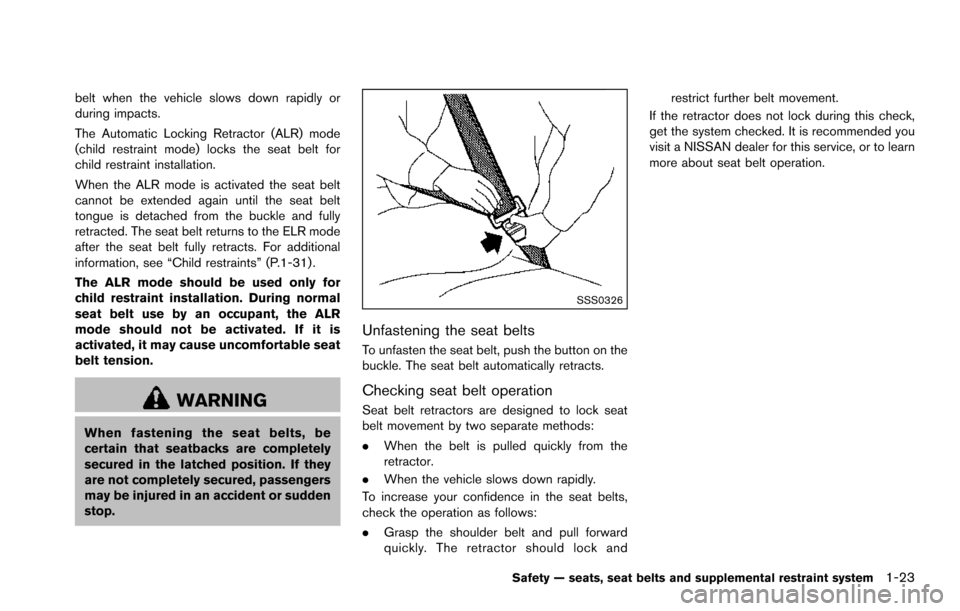
belt when the vehicle slows down rapidly or
during impacts.
The Automatic Locking Retractor (ALR) mode
(child restraint mode) locks the seat belt for
child restraint installation.
When the ALR mode is activated the seat belt
cannot be extended again until the seat belt
tongue is detached from the buckle and fully
retracted. The seat belt returns to the ELR mode
after the seat belt fully retracts. For additional
information, see “Child restraints” (P.1-31) .
The ALR mode should be used only for
child restraint installation. During normal
seat belt use by an occupant, the ALR
mode should not be activated. If it is
activated, it may cause uncomfortable seat
belt tension.
WARNING
When fastening the seat belts, be
certain that seatbacks are completely
secured in the latched position. If they
are not completely secured, passengers
may be injured in an accident or sudden
stop.
SSS0326
Unfastening the seat belts
To unfasten the seat belt, push the button on the
buckle. The seat belt automatically retracts.
Checking seat belt operation
Seat belt retractors are designed to lock seat
belt movement by two separate methods:
.When the belt is pulled quickly from the
retractor.
. When the vehicle slows down rapidly.
To increase your confidence in the seat belts,
check the operation as follows:
. Grasp the shoulder belt and pull forward
quickly. The retractor should lock and restrict further belt movement.
If the retractor does not lock during this check,
get the system checked. It is recommended you
visit a NISSAN dealer for this service, or to learn
more about seat belt operation.
Safety — seats, seat belts and supplemental restraint system1-23
Page 43 of 614
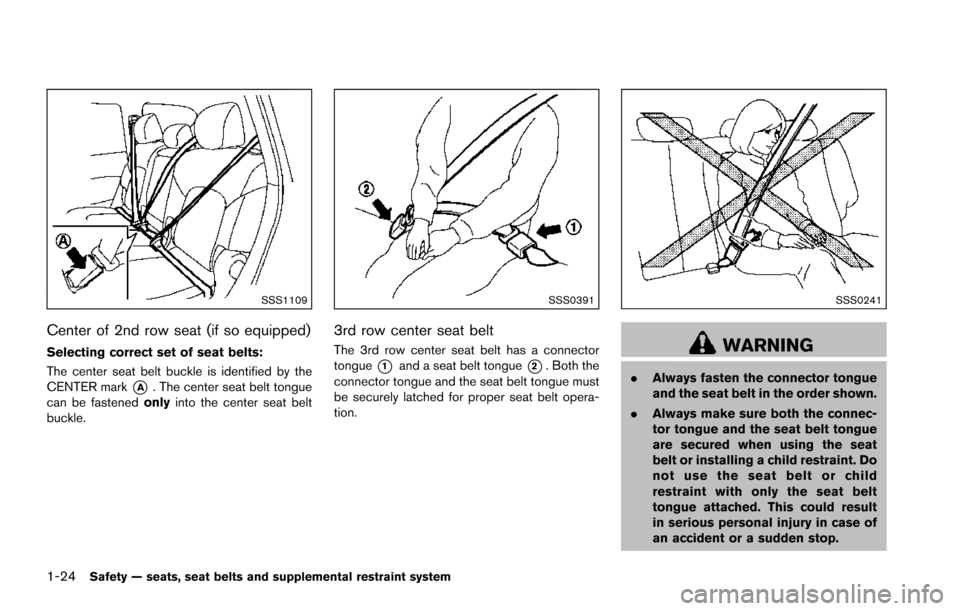
1-24Safety — seats, seat belts and supplemental restraint system
SSS1109
Center of 2nd row seat (if so equipped)
Selecting correct set of seat belts:
The center seat belt buckle is identified by the
CENTER mark
*A. The center seat belt tongue
can be fastened onlyinto the center seat belt
buckle.
SSS0391
3rd row center seat belt
The 3rd row center seat belt has a connector
tongue
*1and a seat belt tongue*2. Both the
connector tongue and the seat belt tongue must
be securely latched for proper seat belt opera-
tion.
SSS0241
WARNING
. Always fasten the connector tongue
and the seat belt in the order shown.
. Always make sure both the connec-
tor tongue and the seat belt tongue
are secured when using the seat
belt or installing a child restraint. Do
not use the seat belt or child
restraint with only the seat belt
tongue attached. This could result
in serious personal injury in case of
an accident or a sudden stop.
Page 45 of 614

1-26Safety — seats, seat belts and supplemental restraint system
Attaching 3rd row center seat belt:
Always be sure the 3rd center seat belt
connector tongue and connector buckle are
attached. Disconnect only when folding down
the 3rd row seat.
To connect the buckle:
1. Pull out the connector tongue from theretractor base
*1.
2. Pull out the seat belt tongue from the tongue holder
*B*2.
3. Pull the seat belt and fasten the connector buckle until it clicks
*3.
The center seat belt connector tongue and
buckle are identified by the
andmark.
The center seat belt connector tongue can be
attached only into the 3rd center seat belt
connector buckle.
To fasten the seat belt, see “Fastening the seat
belts” (P.1-22) .
WARNING
. When attaching the 3rd center seat
belt connector, be certain that the
seatbacks are completely secured in
the latched position and the 3rd
center seat belt connector is com- pletely secured.
. If the 3rd center seat belt connector
and the seatbacks are not secured
in the correct position, serious per-
sonal injury may result in an acci-
dent or sudden stop.
SSS1097
Storing 3rd row seat belt buckles
Before folding down the seat, put the buckles in
the storage of the seat cushion to avoid
dropping it under the seat cushion.
Page 46 of 614

SSS0896
Shoulder belt height adjustment (for front
seats and 2nd row seats)
The shoulder belt anchor height should be
adjusted to the position best for you. (See
“Precautions on seat belt usage” (P.1-18) .)
To adjust, push the button
*A, and then move
the shoulder belt anchor to the desired position,
so that the belt passes over the center of the
shoulder. The belt should be away from your
face and neck, but not falling off of your
shoulder. Release the adjustment button to lock
the shoulder belt anchor into position.
WARNING
. After adjustment, release the ad-
justment button and try to move the
shoulder belt anchor up and down
to make sure it is securely fixed in
position.
. The shoulder belt anchor height
should be adjusted to the position
best for you. Failure to do so may
reduce the effectiveness of the
entire restraint system and increase
the chance or severity of injury in an
accident.
SEAT BELT EXTENDERS
If, because of body size or driving position, it is
not possible to properly fit the lap-shoulder belt
and fasten it, an extender that is compatible with
the installed seat belts is available that can be
purchased. The extender adds approximately 8
in (200 mm) of length and may be used for either
the driver or front passenger seating position. It
is recommended you visit a NISSAN dealer for
assistance with purchasing an extender if an
extender is required.
WARNING
.It is recommended that only
NISSAN seat belt extenders, made
by the same company which made
the original equipment seat belts,
be used with the NISSAN seat belts.
. Adults and children who can use the
standard seat belt should not use an
extender. Such unnecessary use
could result in serious personal
injury in the event of an accident.
. Never use seat belt extenders to
install child restraints. If the child
restraint is not secured properly, the
child could be seriously injured or
killed in a collision or a sudden stop.
SEAT BELT MAINTENANCE
.To clean the seat belt webbing, apply a
mild soap solution or any solution recom-
mended for cleaning upholstery or carpets.
Then, wipe with a cloth and allow the seat
belts to dry in the shade. Do not allow the
seat belts to retract until they are completely
dry.
. If dirt builds up in the shoulder belt
guide of the seat belt anchors, the seat
Safety — seats, seat belts and supplemental restraint system1-27